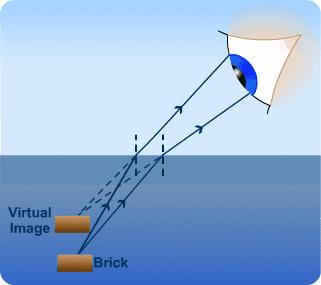What are the Effects of the Refraction of Light ?

What is Refraction of Light?: This is the change of direction for a ray of light or a wave when it passes from one medium to another. There is a change in the medium also. This is called as Refraction of Light and this is one of the most observed phenomenon as in Physical Science and there are other waves as well related to this concept and they are Sound Waves, Water Waves, Optic Eaves etc. ence the wave which is being refracted is actually the change in the speed of the wave and the direction of the wave that is relative to the speed change and its direction.
Why Light in a medium slows down: When we talk of speed of light it is slower in mediums other than vacuum. This slowing is caused by some external factors like air, water or glass and these are therefore responsible for the slowing down or refraction of light as we call it. When the ray of light leaves the medium and it goes into vacuum space then the effects of gravity do not work and thus the speed will come back to the usual speed of the light in vacuum.
When we talk of refraction we can say that when light is being scattered and it is then either absorbed or it is reemitted sometimes by atoms or by particles. This there is an explanation that there is a blurring effect on the light and this is because it no longer travels in one straight line towards one direction. This is however not seen and not evident in future.
When we talk of the nature of the light waves let us talk of the electromagnetic wave and this is the light which is an electric or magnetic wave and thus the light will travel fast in a medium. This so happens because the charged electrons for the materials also oscillate. This is more accurate to say that the protons move and thus they are bigger and more massive in nature. Their movement and effect is also very negligible. These proton will emit electromagnetic wave of its own and thus the waves that are emitted are those by the electrons and these then interact with the electromagnetic waves. This is known as constructive interference. When the two waves clash and interfere with each other then it is known as having a combined result wave. These are however very slow. The light wave is also slow. When the waves leave there is no longer any interaction so it comes back to normal.
Also Check: playvalorant
How can we explain the light bending as it goes into and out of the medium:
We will first consider a light wave that goes from one medium to another and the speed will thus get slow. If the wave reaches the point where the angle on one side where the material lie will reach the second one therefore it will slow down before. When the one side gets slower then the wave which is whole of it will point towards that side. Thus the wave bends accordingly towards the surface and towards the normal when in a material which is slower.
In the opposite case of a wave reaching a material where the speed is higher, the wave will intensify and speed up and the wave will move away from the side. Refraction will occur when light will go through water and there is a refractive index of 1.33 and air has Refractive index of 1.
What is Dispersion:
This is caused by Refraction also and thus the white light is splitter into some rainbow spectrum and this happens as it goes like in a prism. Glass has high refractive index and this is higher than air. When light beam passes from air into some material with an index of refraction that is different with frequency, the phenomenon will happen which is known as dispersion. Here the components of different colour of the white light will then have refraction of angles which are also different and they will thus bend by amounts which are different at the interface and they become separated. The colors that are seem will each correspond to different frequencies. The refractive index of air will spend on air density and it will be different from temperature and pressure. Pressure is low at high altitudes and thus the refractive index is lower. It does have light rays which refracts from the earth’s surface and it will thus travel long distances in the atmosphere.
Solve the question: If an object of 7 cm height is placed at a distance of 12 cm from a convex lens of focal length 8 cm, find the position, nature and height of the image.
Visit for more website: forbesblog.org


